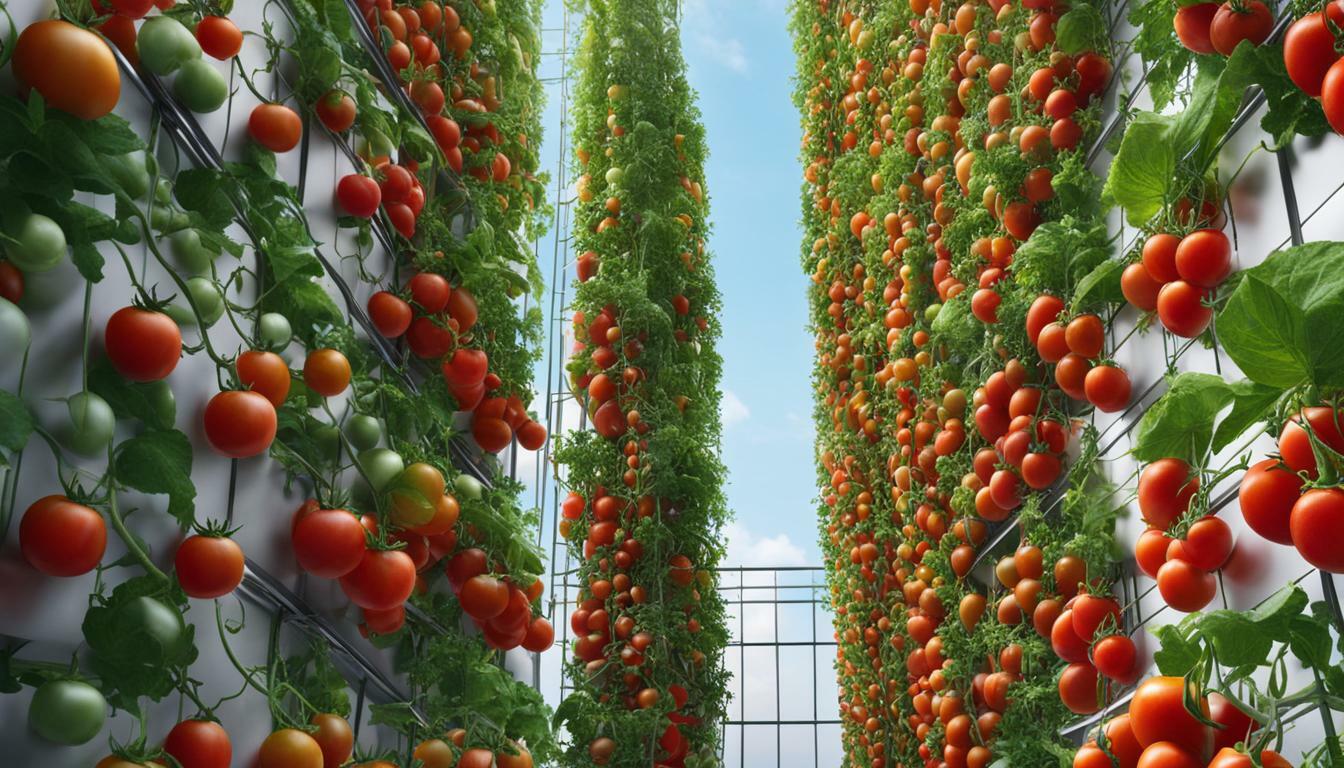Are you looking to maximize your tomato crop yield? Consider using an artificial vertical garden, which offers ample space and ease of cultivation, allowing you to cultivate your green thumb and enjoy bountiful yields of delicious tomatoes. With a vertical garden, you can optimize your gardening space and grow tomatoes in a vertical arrangement, taking advantage of the available height and maximizing sunlight exposure for your plants.
- Artificial vertical gardens provide ample space for growing tomatoes, allowing you to make the most of your gardening area.
- Vertical gardening makes cultivation easier, as plants can be easily accessed for pruning, watering, and harvesting.
- A vertical garden enables better air circulation around the tomato plants, reducing the risk of fungi and other diseases.
- With a vertical garden, you can optimize sunlight exposure for your tomatoes, ensuring they receive ample light for healthy growth and optimal fruit production.
- Vertical gardening helps maximize yields by utilizing vertical space, allowing you to grow more tomato plants in a limited area.
By utilizing an artificial vertical garden for tomatoes, you can create an efficient and productive growing environment. With the right care and attention, you can enjoy a bountiful harvest of delicious tomatoes while making the most of your available space. So, get ready to start cultivating your green thumb and enjoy the benefits of a vertical garden for your tomato crop.
The Benefits of Vertical Gardening for Tomatoes
Vertical gardening for tomatoes offers a multitude of benefits that can enhance your growing experience and yield. From easier pruning to improved application of fungicides and nutrients, better air circulation, maximum sunlight exposure, space optimization, and reduced risk of soil-borne diseases, a vertical garden can help you achieve optimal results.
Pruning is an essential aspect of tomato farming, and a vertical garden makes it much more manageable. With vines attached to a trellis or stake, the pruning process becomes easier as the vines are clearly visible and can be accessed without having to sift through the soil. By pruning your tomato plants, you can produce tastier fruit and speed up ripening.
Vertical gardens also provide easier application of fungicides, pesticides, and nutrient sprays. The vertical growth of the plants makes them more accessible for these applications, allowing you to tend to your crop without having to navigate through the soil. Furthermore, the vertical orientation of the plants ensures better air circulation, minimizing the risk of diseases and pests that thrive in overcrowded and poorly ventilated environments.
Another advantage of vertical gardening for tomatoes is the maximum sunlight exposure it provides. Each fruit and vine in a vertical garden has its own space to absorb sunlight, ensuring optimal growth and ripening. Unlike traditional gardens where shade from taller plants may obstruct sunlight, the vertical orientation of a vertical garden allows for maximum sunlight penetration.
In addition, vertical gardening optimizes space and allows you to grow more tomatoes in a small area. By utilizing the vertical space instead of horizontal, you can conserve valuable garden space for other crops. This is especially beneficial for gardeners with limited space or those looking to maximize their garden’s potential.
To summarize, vertical gardening for tomatoes offers a myriad of benefits, including easier pruning, improved application of fungicides and nutrients, better air circulation, maximum sunlight exposure, space optimization, and reduced risk of soil-borne diseases. With these advantages, a vertical garden can help you grow a bountiful and healthy crop of tomatoes.
Table: Comparison of Traditional Gardening and Vertical Gardening Benefits
| Traditional Gardening | Vertical Gardening |
|---|---|
| Pruning can be challenging due to entangled vines | Pruning is easier with clearly visible vines |
| Difficult to apply fungicides and nutrients | Easier application of fungicides and nutrients |
| Poor air circulation can lead to disease and pest problems | Better air circulation reduces disease and pest risk |
| Shade from taller plants may hinder sunlight exposure | Maximum sunlight exposure for each fruit and vine |
| Limited space for growing tomatoes | Optimized space utilization for increased tomato yield |
| Higher risk of soil-borne diseases | Reduced risk of soil-borne diseases |
“Vertical gardening for tomatoes offers a multitude of benefits that can enhance your growing experience and yield.” – Source 1
Choosing the Right Tomato Varieties for Vertical Gardening
When it comes to vertical gardening for tomatoes, selecting the right tomato varieties is crucial. Determinate tomatoes are ideal for compact vertical gardens, while indeterminate tomatoes are perfect for training and trellising. Pruning and training techniques can further enhance the growth and yield of your vertical tomato garden.
For smaller vertical gardens, determinate tomatoes are a great choice. These varieties grow in a more compact form and have a predetermined height, making them suitable for limited space. They are often bush-like in their growth habit and do not require tall trellises or extensive support. Determinate tomatoes are also well-suited for canning due to their concentrated fruit production during a shorter season.
On the other hand, indeterminate tomatoes are best for vertical gardens where training and trellising are possible. These varieties continue to grow and produce fruit throughout the season, requiring consistent pruning and support. Indeterminate tomatoes can reach heights of six feet or more, making them ideal for vertical gardening. Their vining growth habit allows for easy attachment to stakes, trellises, or other support structures, enabling optimal upward growth and maximizing space utilization. Popular indeterminate tomato varieties include Early Cascade, Sweet Million, and Supersonic.
Pruning and Training Techniques
Pruning and training are essential practices for vertical tomato gardening. Pruning involves removing unnecessary shoots, known as suckers, from the plant to direct energy into fruit production. Regular pruning helps maintain a manageable size and promotes better air circulation, reducing the risk of diseases and increasing overall plant health. Training techniques, such as attaching the tomato vines to stakes or trellises, help guide the plants’ upward growth and prevent sprawling.
Proper pruning and training can also enhance the yield and quality of the tomatoes. By removing excessive foliage and directing nutrients toward fruit development, pruning promotes larger, healthier tomatoes. Additionally, training the vines vertically allows for better sunlight exposure, which is crucial for optimal photosynthesis and fruit ripening.
| Tomato Type | Growth Habit | Suitable for Vertical Gardening | Pruning and Training Requirements |
|---|---|---|---|
| Determinate | Bush-like | Yes, ideal for compact vertical gardens | Minimal pruning required, suitable for canning |
| Indeterminate | Vining | Yes, perfect for training and trellising | Regular pruning and support needed, continuous fruit production |
“When it comes to vertical gardening for tomatoes, selecting the right tomato varieties is crucial. Determinate tomatoes are ideal for compact vertical gardens, while indeterminate tomatoes are perfect for training and trellising.”
Trellis Options for Vertical Tomato Gardening
To support your vertical tomato garden, there are several trellis options you can choose from. Stake fence support, string trellising, stake and string combination, hanging fence or netting, and concrete mesh are all viable choices that offer different advantages based on your tomato variety and personal preference.
1. Stake Fence Support
An excellent and affordable option is using stake fence support. This simple trellis system involves attaching a section of welded wire fencing to a wooden stake. It works well for both bush and vining tomatoes and is easily adjustable based on the recommended height for your plants. As the tomatoes grow, you can use string or cloth strips to tie them to the trellis, keeping the leaves and stems off the ground. Stake fence support provides stability and protection from pests, diseases, and foot traffic.
2. String Trellising
String trellising is another cost-effective method that requires minimal materials. It can be used both indoors and outdoors. For determinate varieties, you can use a horizontal string trellis where string runs across a frame, forming a support on either side of each plant. This method is not suitable for heavy pruning. For indeterminate varieties, a vertical hanging trellis works well. It involves attaching strings to posts placed at regular intervals along the row and letting them descend to the ground. The plants can then be wrapped or clipped to the string, providing support as they grow.
3. Stake and String Combination
The stake and string combination is a popular trellis option for vertical tomato gardening. It involves pounding wooden stakes next to each plant and attaching strings from the stakes to a horizontal frame. This method provides early support for the tomatoes and allows for vertical growth. Cedar or metal fencing stakes can be used, and jute or sisal string is ideal for tying the plants to the stakes. This trellis option is convenient as it provides stability and is biodegradable, simplifying cleanup after harvesting.
4. Hanging Fence or Netting
If you prefer allowing your indeterminate tomatoes to develop multiple leaders or heads, using a hanging fence or netting is a suitable choice. It requires constructing a frame that can accommodate fencing or netting as tall as your plants are likely to grow. As the season progresses, you can clip, tie, or weave the plants to the fencing, providing support and preventing them from falling over. It is important to create loose loops around the stalks or branches to avoid choking the plants as they grow.
5. Concrete Mesh
Concrete mesh is a relatively inexpensive trellis system that offers sturdy support for indeterminate tomato plants. It is made from 9-gauge wire crafted into 6-inch squares and is typically used for reinforcing concrete. Concrete mesh is rust-resistant and durable, making it a long-lasting option for vertical tomato gardening. The material allows for adequate air circulation and sunlight exposure while conserving garden space. It can be easily cut and shaped without special tools, providing a versatile and reliable trellis solution.
By choosing the right trellis option for your vertical tomato garden, you can ensure optimal growth, maximize space efficiency, and protect your plants from pests and diseases. Consider the characteristics of your tomato varieties and the specific requirements of your gardening space when selecting a trellis system. With proper support and care, you can enjoy bountiful harvests of delicious homegrown tomatoes.
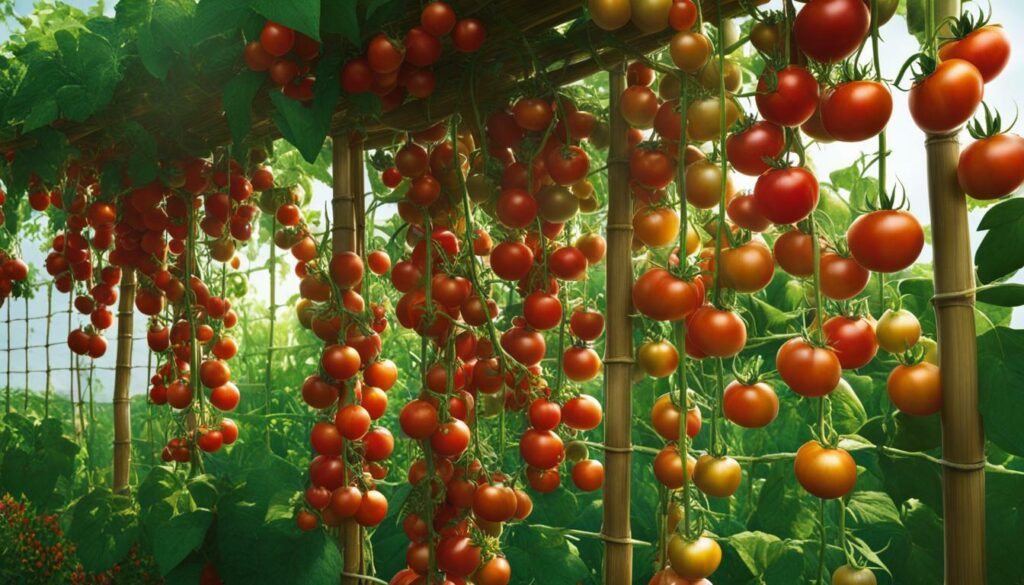
How to Grow Tomatoes Vertically in a Garden
Growing tomatoes vertically in a garden is an excellent way to maximize space and yield. Follow these step-by-step tips to successfully grow tomatoes vertically: build a vertical system, choose the right pot size, select suitable tomato varieties (determinate or indeterminate), and implement proper pruning and training techniques. Whether you’re growing tomatoes indoors or outdoors, these tips will help you achieve optimal results.
Building a vertical system is the first step in growing tomatoes vertically. Consider using trellises, stakes, or cages to provide support for the plants as they grow. This not only helps keep the vines off the ground but also ensures adequate air circulation and sunlight exposure. You can use materials such as stake fence support, string trellising, stake and string combination, hanging fence or netting, or even concrete mesh for your vertical system.
When it comes to pot size, choose containers that are at least 8 inches deep to allow for proper root development. This will provide enough space for the tomato plants to grow vertically. Keep in mind that determinate tomatoes, which grow for a shorter season, require smaller pots or patio containers, while indeterminate tomatoes, which grow and set fruit throughout the season, need larger pots to accommodate their continuous growth.
When selecting tomato varieties for vertical gardening, consider whether they are determinate or indeterminate. Determinate varieties, such as San Marzanos and Goliaths, are compact and bush-like, making them suitable for small spaces. Indeterminate varieties, on the other hand, grow in vines and can reach heights of 6 feet or more. Choose varieties that are well-suited for vertical growth and provide ample fruit production.
Proper pruning and training techniques are crucial for vertical tomato gardening. Regularly prune your plants to remove suckers and encourage upward growth. Use stakes, trellises, or twine to support the vines and guide their growth. This will help prevent the plants from sprawling and maximize their vertical growth potential.
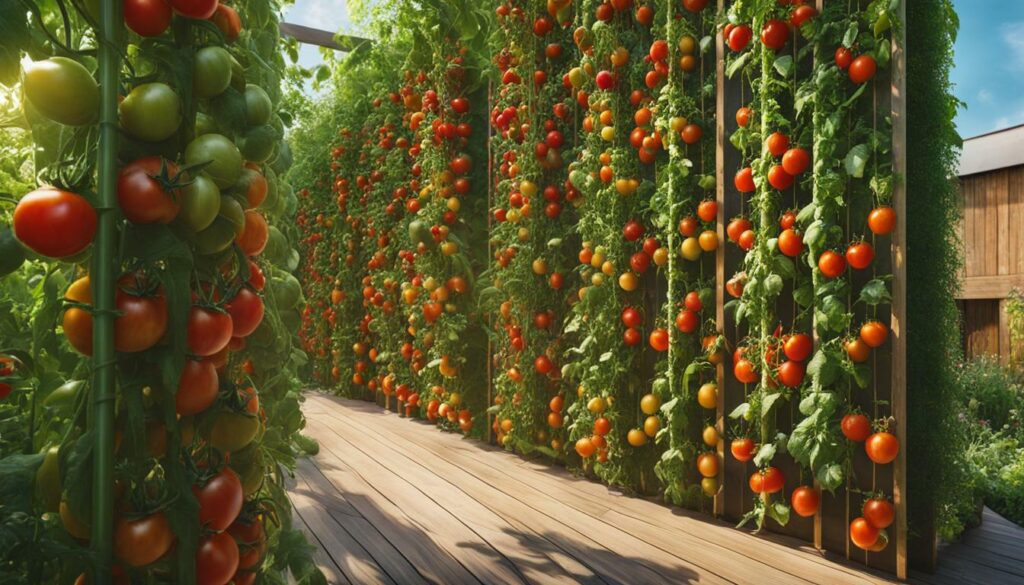
| Trellis Options | Benefits | Suitable Tomato Varieties |
|---|---|---|
| Stake fence support | Simple and inexpensive | Determinate and indeterminate |
| String trellising | Inexpensive and easy to construct | Determinate |
| Stake and string combination | Provides additional support | Indeterminate |
| Hanging fence or netting | Allows for multiple plant leaders | Indeterminate |
| Concrete mesh | Relatively inexpensive and sturdy | Indeterminate |
By following these tips, you can successfully grow tomatoes vertically in a garden. Whether you choose to grow them indoors or outdoors, providing a vertical system, selecting the right pot size, choosing suitable tomato varieties, and implementing proper pruning and training techniques will help you achieve bountiful yields and make the most of your available space.
Tips for Growing Tomatoes Indoors in a Vertical Garden
Growing tomatoes indoors in a vertical garden requires careful attention to lighting, temperature, pot depth, and air circulation. Follow these tips to ensure the success of your indoor tomato garden and enjoy a bountiful harvest.
1. Lighting: Tomatoes thrive in full sun, so it’s crucial to provide them with adequate lighting. If you don’t have access to natural sunlight, consider using grow lights. Position the lights about six to eight inches above the plants and keep them on for 14 to 16 hours a day. Adjust the height of the lights as the plants grow to maintain the proper distance.
2. Temperature: Tomatoes prefer temperatures between 65 to 80 degrees Fahrenheit. Avoid exposing them to extreme heat or cold, as it can affect their growth and fruit production. Keep the temperature consistent and provide proper ventilation to prevent overheating.
3. Pot Depth: Choose pots or containers with a depth of at least 12 to 16 inches to accommodate the tomato plants’ root system. This allows for ample soil and root space, promoting healthy growth. Ensure the pots have drainage holes to prevent waterlogged soil.
4. Air Circulation: Good air circulation is essential for preventing mold and disease in indoor tomato plants. Place a small fan near the plants to provide gentle airflow, simulating a natural outdoor environment. Avoid placing the fan directly on the plants to prevent excessive drying.
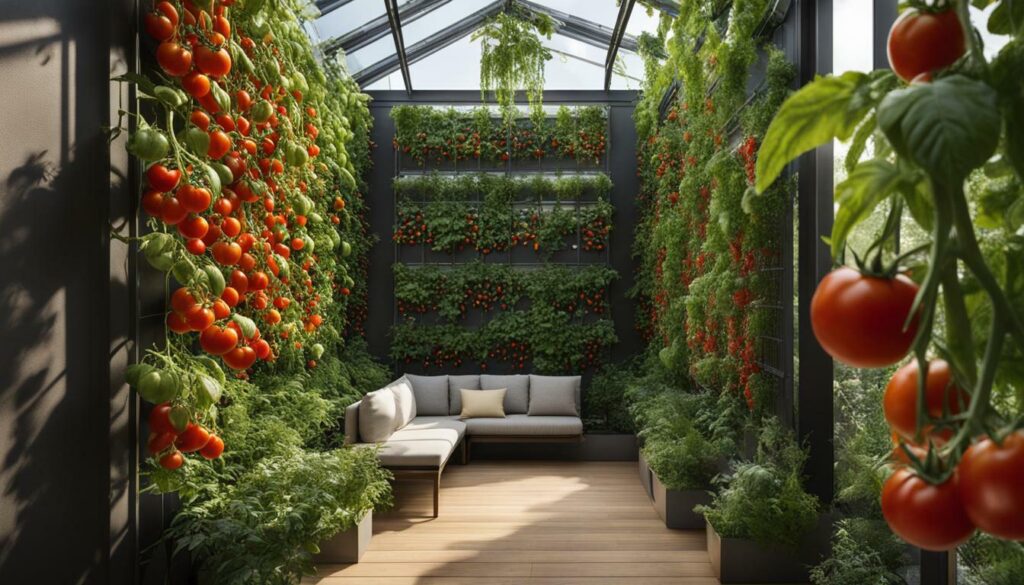
| Key Tips for Growing Tomatoes Indoors |
|---|
| Provide adequate lighting |
| Maintain a consistent temperature |
| Use pots with sufficient depth |
| Promote air circulation with a fan |
| Fertilize regularly |
| Water consistently, but avoid overwatering |
In addition to these tips, remember to fertilize your indoor tomato plants regularly with a balanced fertilizer. Follow the instructions on the fertilizer packaging to ensure proper application. Water the plants consistently, keeping the soil moist but not waterlogged. Avoid overwatering, as it can lead to root rot and other issues.
By implementing these tips, you can create a thriving vertical garden of tomatoes indoors and enjoy the taste of fresh, homegrown tomatoes year-round.
Tips for Growing Tomatoes Outdoors in a Vertical Garden
Growing tomatoes outdoors in a vertical garden requires attention to the right location, soil preparation, watering techniques, staking, pruning, and other specific considerations. Follow these tips to ensure successful outdoor tomato gardening and enjoy a bountiful harvest.
1. Choose the right location: Tomatoes thrive in full sunlight, so select a spot in your garden that receives at least 6-8 hours of direct sunlight each day. Avoid areas with strong winds or excessive shade.
2. Prepare the soil: Prior to planting, prepare the soil by loosening it with a garden fork or tiller. Mix in compost or well-rotted manure to improve drainage and increase nutrient levels. Tomatoes prefer slightly acidic soil with a pH between 6.0 and 6.8.
3. Watering techniques: Tomatoes require consistent moisture to thrive. Water deeply and evenly, ensuring the soil is evenly moist but not waterlogged. Avoid overhead watering, as it can promote the spread of fungal diseases. Consider using a drip irrigation system or soaker hoses for efficient watering.
4. Staking and pruning: As your tomato plants grow, provide support by staking them. Use bamboo poles, tomato cages, or other trellis systems to prevent the plants from sprawling on the ground. Prune the tomato plants by removing suckers – the shoots that emerge from the leaf axils. This promotes better airflow and reduces the risk of disease.
5. Indeterminate varieties: Consider growing indeterminate tomato varieties in your vertical garden. These varieties continue to produce fruit throughout the growing season and benefit from vertical support. Popular indeterminate varieties include ‘Better Boy,’ ‘Big Beef,’ and ‘Cherokee Purple.’
6. Soil-borne disease prevention: To prevent soil-borne diseases, avoid planting tomatoes in the same location year after year. Rotate your tomato crops with other unrelated plants to reduce the risk of disease buildup in the soil.
“Growing tomatoes outdoors in a vertical garden requires attention to the right location, soil preparation, watering techniques, staking, pruning, and other specific considerations.”
| Growing Tips for Outdoor Tomato Gardening |
|---|
| Choose a sunny location for optimum sunlight exposure. |
| Prepare the soil by adding compost or well-rotted manure. |
| Water deeply and evenly, avoiding overhead watering. |
| Provide support for your tomato plants using stakes or trellises. |
| Prune the plants regularly by removing suckers. |
| Consider growing indeterminate tomato varieties for prolonged harvest. |
| Rotate tomato crops to prevent soil-borne diseases. |
Best Tomato Varieties for Vertical Gardening
When it comes to choosing the best tomato varieties for vertical gardening, there are several options to consider. Indeterminate tomatoes with vining growth habits, determinate tomatoes with bush-like formations, and compact varieties are all excellent choices for vertical gardens. Here are some recommended tomato varieties that thrive in vertical gardening setups:
- Brandywine: This indeterminate variety is a favorite among tomato enthusiasts for its rich, sweet flavor and large, meaty fruits. It requires staking or trellising to support its vigorous growth.
- Roma: A determinate tomato variety, Roma is known for its high yields of meaty, flavorful fruits. It is ideal for canning, making sauces, or drying, and its compact growth habit makes it suitable for vertical gardens.
- Cherry Cascade: As the name suggests, this indeterminate cherry tomato variety cascades beautifully from hanging baskets or trellises. It produces an abundance of sweet, bite-sized tomatoes and is perfect for vertical gardens with limited space.
- Patio Princess: This determinate tomato variety is specifically bred for container gardening and compact spaces. It produces medium-sized, flavorful fruits on compact plants, making it an excellent choice for small vertical gardens or patio containers.
These tomato varieties offer a range of flavors, sizes, and growth habits, allowing you to choose the perfect options for your vertical garden. Whether you prefer juicy slicers, sweet cherries, or tomato varieties perfect for canning and sauces, there’s a tomato variety that will thrive in your vertical garden.
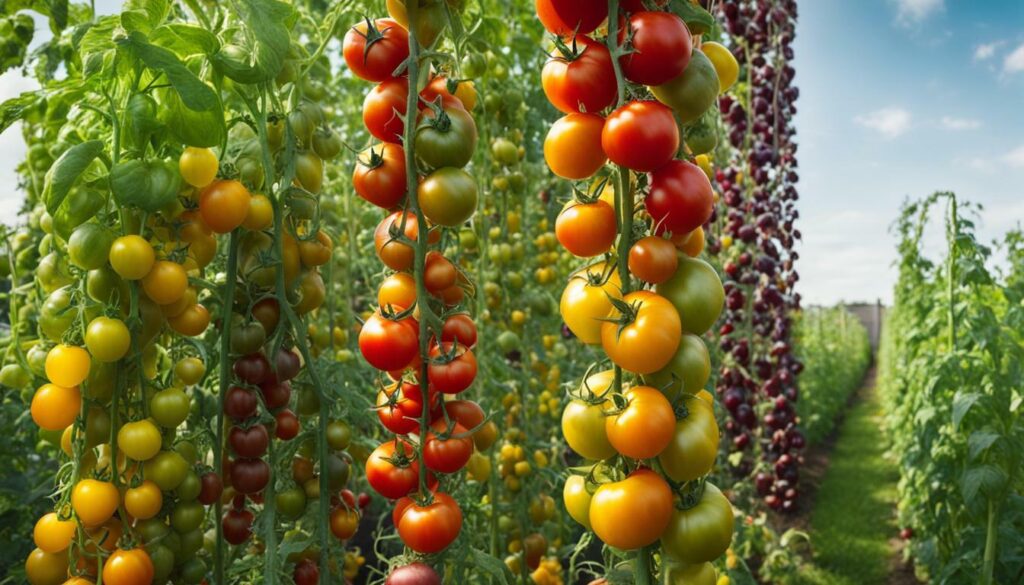
Tips for Growing Tomatoes Vertically
Vertical gardening requires proper care and maintenance to ensure successful tomato growth. Here are some tips to help you grow tomatoes vertically in your garden:
- Provide sturdy support: Use trellises, stakes, or cages to support the tomato plants vertically. This will prevent the vines from sprawling on the ground and promote healthy growth.
- Prune regularly: Remove suckers and excess foliage to maintain airflow and prevent the plants from becoming too dense. Pruning also helps redirect energy to fruit production.
- Water consistently: Tomatoes have deep roots, so deep and consistent watering is essential. Avoid overwatering or allowing the soil to dry out completely.
- Fertilize appropriately: Use a balanced fertilizer or organic compost to provide essential nutrients for healthy growth and abundant fruit production.
- Monitor for pests and diseases: Regularly inspect the plants for signs of pests or diseases, such as aphids or fungal infections. Take necessary action, such as using organic pest control methods or removing infected plants, to prevent further damage.
By following these tips and selecting the right tomato varieties for vertical gardening, you can enjoy a bountiful harvest of fresh, flavorful tomatoes from your vertical garden.
| Tomato Variety | Growth Habit | Recommended for |
|---|---|---|
| Brandywine | Indeterminate | Staking or trellising |
| Roma | Determinate | Compact vertical gardens |
| Cherry Cascade | Indeterminate | Small vertical gardens or hanging baskets |
| Patio Princess | Determinate | Container gardening or small vertical gardens |
With the right tomato varieties and proper care, you can enjoy a thriving vertical garden filled with delicious, homegrown tomatoes. Experiment with different varieties and techniques to find what works best for your space and preferences. Happy vertical gardening!
Conclusion
Vertical gardening for tomatoes offers numerous benefits, including increased yields, efficient use of space, and improved plant health. By implementing the right trellis options, selecting suitable tomato varieties, and following proper care techniques, you can maximize your tomato crop and enjoy a plentiful harvest. Start your vertical tomato gardening journey today and experience the joy of growing your own delicious tomatoes.
One of the key advantages of vertical gardening for tomatoes is the ability to increase yields. By utilizing trellises and other vertical structures, you can provide ample space for your tomato plants to grow and thrive. This vertical growth allows for optimal air circulation and sunlight exposure, which are crucial for reducing the risk of disease and promoting fruit ripening.
In addition to maximizing space, vertical gardening for tomatoes also offers the opportunity to optimize plant health. By pruning and training your tomato plants, you can encourage upward growth and prevent the spread of diseases. This method also allows for easier application of fungicides, pesticides, and nutrient sprays, as the plants are easily accessible and not entangled on the ground.
When it comes to choosing the right tomato varieties for vertical gardening, indeterminate tomatoes are highly recommended. These vine-like plants are perfect for vertical growth and can be easily attached to stakes or trellises. Determinate tomatoes, on the other hand, have a bush-like growth habit and may not be as suitable for vertical gardening. By selecting the right tomato varieties, you can ensure the success of your vertical garden.
In conclusion, vertical gardening for tomatoes provides a range of benefits, from increased yields to efficient space utilization. By implementing trellis options, selecting suitable tomato varieties, and following proper care techniques, you can enjoy a bountiful harvest of delicious homegrown tomatoes. So why wait? Start your own vertical tomato garden and experience the joy of growing your own fresh produce.
Can I Use the Same Vertical Garden Setup for Tomatoes as I Would for Zucchini?
Yes, you can use the same vertical zucchini garden techniques for tomatoes as well. Both of these plants thrive in a vertical setup, allowing for better air circulation and easier access for harvesting. Just make sure to provide adequate support for the weight of the plants as they grow.
FAQ
Q: What are the benefits of vertical gardening for tomatoes?
A: Vertical gardening for tomatoes offers several benefits, including easier pruning, improved application of fungicides and nutrients, better air circulation, maximum sunlight exposure, space optimization, and reduced risk of soil-borne diseases.
Q: What types of tomato varieties are suitable for vertical gardening?
A: Determinate tomato varieties are more suitable for vertical gardening as they have a set height and can be easily maintained. Indeterminate varieties can also be grown vertically but may require more pruning and training to control their growth.
Q: What are some trellis options for vertical tomato gardening?
A: There are several trellis options for vertical tomato gardening, including stake fence support, string trellising, stake and string combination, hanging fence or netting, and concrete mesh. Each option provides different benefits and is suitable for different tomato varieties.
Q: How can tomatoes be grown vertically in a garden?
A: To grow tomatoes vertically in a garden, you need to build a vertical system, choose the right pot size, select determinate or indeterminate tomato varieties, prune and train the plants, and take specific considerations for indoor or outdoor gardening.
Q: What are some tips for growing tomatoes indoors in a vertical garden?
A: When growing tomatoes indoors in a vertical garden, it is important to provide proper lighting, maintain the right temperature, ensure sufficient pot depth, and promote adequate air circulation.
Q: What are some tips for growing tomatoes outdoors in a vertical garden?
A: When growing tomatoes outdoors in a vertical garden, it is important to choose a sunny location, prepare the soil, water properly, stake and prune the plants, and consider the specific needs of indeterminate tomato varieties.
Q: What are some recommended tomato varieties for vertical gardening?
A: Recommended tomato varieties for vertical gardening include both indeterminate and determinate varieties, as well as compact varieties suitable for small vertical garden spaces. Some examples include Early Cascade, Sweet Million, and Supersonic.

